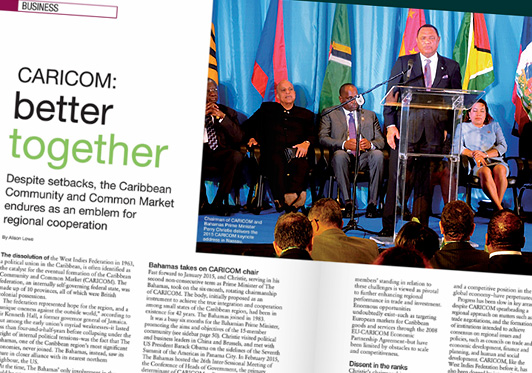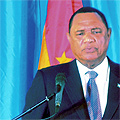| Published: Date: Updated: Author: |
The Bahamas Investor Magazine July 28, 2016 July 28, 2016 Alison Lowe |
The dissolution of the West Indies Federation in 1963, a political union in the Caribbean, is often identified as the catalyst for the eventual formation of the Caribbean Community and Common Market (CARICOM). The federation, an internally self-governing federal state, was made up of 10 provinces, all of which were British colonial possessions.
The federation represented hope for the region, and a “unique oneness against the outside world,” according to Sir Kenneth Hall, a former governor general of Jamaica. But among the early union’s myriad weaknesses–it lasted less than four-and-a-half-years before collapsing under the weight of internal political tensions–was the fact that The Bahamas, one of the Caribbean region’s most significant economies, never joined. The Bahamas, instead, saw its future in closer alliance with its nearest northern neighbour, the US.
At the time, The Bahamas’ only involvement in the group would be retrospectively symbolic. A young Bahamian athlete, Perry Christie, who would later serve as Prime Minister of The Bahamas, competed in the West Indies Federation Games in 1960.
Bahamas takes on CARICOM chair
Fast forward to January 2015, and Christie, serving in his second non-consecutive term as Prime Minister of The Bahamas, took on the six-month, rotating chairmanship of CARICOM. The body, initially proposed as an instrument to achieve the true integration and cooperation among small states of the Caribbean region, had been in existence for 42 years. The Bahamas joined in 1983.
It was a busy six months for the Bahamian Prime Minister, promoting the aims and objectives of the 15-member community. Christie visited political and business leaders in China and Brussels, and met with US President Barack Obama on the sidelines of the Seventh Summit of the Americas in Panama City. In February 2015, The Bahamas hosted the 26th Inter-Sessional Meeting of the Conference of Heads of Government, the primary determinant of CARICOM policy steps.
Among the most pressing challenges facing the region are climate change, high energy costs, crime and justice, growing human capital, and building and maintaining competitiveness in services industries such as tourism and finance, and exports such as oil. Improving CARICOM members’ standing in relation to these challenges is viewed as pivotal to further enhancing regional performance in trade and investment.
Enormous opportunities undoubtedly exist–such as targeting European markets for Caribbean goods and services through the 2008 EU-CARICOM Economic Partnership Agreement–but have been limited by obstacles to scale and competitiveness.
Dissent in the ranks
Christie’s chairmanship came eight months after he argued for CARICOM’s continued relevance in the face of dissent. The same issues that had been a major impetus to its creation–the smallness of states within the region hindering economies of scale, specialization and a competitive position in the global economy–have perpetuated.
Progress has been slow in key areas, despite CARICOM spearheading a regional approach on matters such as trade negotiations, and the formation of institutions intended to achieve consensus on regional issues and policies, such as councils on trade and economic development, finance and planning, and human and social development. CARICOM, like the West Indies Federation before it, has also been dogged by intra-political tensions, lack of “buy in” from stakeholders and, consequently, accusations of ineffectiveness arising from what St Vincent and the Grenadines Prime Minister Ralph Gonsalves called its “frustrating unfulfilled potential.” The divisions threatened to tear the organization apart.
The focal point of CARICOM’s regional ambitions is the Caribbean Single Market and Economy (CSME), proposed in 1989 to deepen the integration initiative of CARICOM and to more successfully respond to globalization. With a 64 per cent implementation rate after 27 years, it is viewed by many as having largely stalled.
Building on the earlier common market initiative established by CARICOM among its members by liberalizing not only trade in goods but also in services, CSME was proposed to give Caribbean nationals new freedoms. Under the agreement, Caribbean nationals would be allowed to establish a business in any CARICOM member state and be treated like a citizen of that country. Similarly, skilled labour and capital would flow freely across state borders, allowing greater choice for consumers, generating more competition and stimulating enhanced economic activity and economics of scale.
Even at the level of financial resources needed to fund the CARICOM Secretariat through member states’ dues, genuine pooling of regional resources towards addressing longstanding and mutual impediments has been lacking. This has been the case notwithstanding historic consensus that pooling is the most promising means of pushing the region onto a higher echelon of growth and development.
This is one of the reasons why today, for reasons both internal and external, CARICOM now finds itself facing “one of the most challenging and dynamic economic and social epochs” in its history. Low growth and high debt have reversed hard-won gains in economic and social development in the region. The Silent Debt Crisis, a recent report by credit ratings agency Moody’s, reveals that as many as 12 of 20 Caribbean-region countries have a debt-to-GDP ratio above 60 per cent. The Bahamas’ debt-to-GDP ratio hit 67.8 per cent in 2015. Six Caribbean countries have debt-to-GDP ratios over 80 per cent and four over 100 per cent.
First strategic plan
But the dream of CARICOM has not been set aside. The Bahamas’ chairmanship in January 2015 coincided with the launch of Repositioning CARICOM, an ambitious five-year plan to reorganize the regional body. CARICOM’s first strategic plan is aimed at reconfiguring the entity to better address not only the new and ongoing challenges of the region, but also organizational weaknesses that have contributed to a lack of anticipated forward progress to date.
Throughout the plan, the theme of resilience is emphasized, whether it be economic, social, environmental or technological, as is the need to foster a greater sense of “CARICOM identity.” There is also the explicit recognition that given the limited resources of the CARICOM Secretariat and its member states, “high priority” is placed on limited issues, including accelerating the implementation of the CSME.
“A range of targeted interventions will be applied to address critical gaps over the planning period; for example, to mitigate and overcome the high-debt, low-growth, vulnerabilities to environmental shocks and the general need for re-balancing intra-regional trade between member states,” according to the plan. To achieve this, there has been a call for transformational reform of the institution’s methods of operation and increased “buy in” from member states.
Better together
In the words of Prime Minister Christie, in the past The Bahamas has had “one foot in and one foot out” of CARICOM. However, The Bahamas has recently been an important contemporary advocate for the regional body. According to director general at the Ministry of Foreign Affairs, Sharon Brennen- Haylock, today The Bahamas has “a very strong relationship with CARICOM,” notwithstanding that it continues to opt out of the CSME.
“CARICOM states work in a collaborative manner in many fora. This cooperation has resulted in advantageous outcomes in the international arena, such as the United Nations, the Organization of American States, EU-ACP, as well as other plurilateral forums, such as UK-Caribbean, USA-CARICOM and Canada-CARICOM,” explains Brennen-Haylock.
This strong relationship was all but confirmed by Prime Minister Christie when he spoke at The University of the West Indies’ Distinguished Open Lecture Series in Trinidad and Tobago in April 2014. “It is my firm personal view and the official view of The Bahamas that we all work better when we work together. The region is stronger when we pool our national sovereignties and identities and work in concert with each other.”
Brennen-Haylock says The Bahamas is committed to playing a significant role in “promoting both domestic and regional interests” through CARICOM. An example of member states doing just that was the recent response to the so-called “de- risking” strategies by international banks that carry out correspondent functions for Caribbean banks. In February, current CARICOM chair, Dean Barrow, Prime Minister of Belize, promised that it would “wage a relentless campaign” in response to the risk that international banks may stop doing business with client banks in the region–threatening their financial and economic order–out of concerns over compliance.
Meanwhile, Brennen-Haylock says there is an even greater general threat to the region, and The Bahamas in particular: climate change. Joint efforts to address climate change have been “highly effective,” she says. CARICOM put forward an “excellent team” as regional ambassadors leading up to the 2015 United Nations Conference on Climate Change in Paris, notes Brennen-Haylock. The final signatory meeting of the Climate Accord took place at the UN in April, and CARICOM member states agreed to join the meeting at the highest level possible, to ensure the agreement from the Conference of Parties 21 (COP21) is fully implemented.
“CARICOM member states work together on a range of issues of mutual concern and interest, such as matters pertaining to Small Island Developing States (SIDS), sustainable development, the effects of climate change, while being a voting force to ensure implementation of carbon reduction,” Brennen-Haylock says. “The region also works on issues of regional security, banking, health–in particular non-communicable diseases–human rights and trade.”










